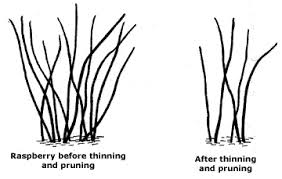“We purchased many bare root raspberries and blueberries in the spring for our new garden…. Many of the raspberries bore fruit this fall. I’m wondering how they should both be pruned this fall? Please
advise…
Thanks
Jesse”
______________________________________________________________
Hi Jesse,
Thank you for the email regarding your raspberries and blueberries.
First question: do you have summer-bearing/everbearing or fall-bearing types of raspberries?
 If you have a summer-bearing and everbearing types of raspberry, you do not want to prune it in general. The berries will be produced on canes from the previous year. The only ones that you should think about pruning would be those that have grown up beyond the area you have designated for them, or any that are spindly or diseased.
If you have a summer-bearing and everbearing types of raspberry, you do not want to prune it in general. The berries will be produced on canes from the previous year. The only ones that you should think about pruning would be those that have grown up beyond the area you have designated for them, or any that are spindly or diseased.
As for fall-bearing types, you definitely want to prune them in late winter/early spring before the buds break dormancy. Prune all canes that bore fruit last year; they won’t fruit again. These will have grayish,
peeling bark. To force your everbearing raspberries to produce only one crop in the fall, prune back the entire raspberry bush in early spring. As the canes grow back in the summer, remove outside suckers and thin the canes to about 6 inches apart. Keep the sturdiest canes. This technique will give you a larger fall harvest and is good if you also have summer bearing raspberry bushes and you want to stagger the harvests.
As the summer goes on, you can always prune out any dead, broken or diseased canes or those that are outside your designated row area. Of course, you can prune broken, dead, diseased or infested canes at any time of the year, the sooner the better.
And one other thing: wear thick gloves as raspberries have some serious thorns on them. And use clean, sharp tools.
As for the blueberries, spring is the best time to prune. Before domancy has broken, remove any diseased or broken wood, plus crossing branches. You want the bush to have a narrow base and a wide, open top that allows sunlight and air in.
I hope this information helps you out. If you have any other questions, please feel free to ask.
*************************************************************************
© Mertie Mae Botanics LLC and Horticulture Talk!, 2015. Unauthorized use and/or duplication of this material without express and written permission from this blog’s author and/or owner is strictly prohibited. Excerpts and links may be used, provided that full and clear credit is given to Mertie Mae Botanics LLC and Horticulture Talk! with appropriate and specific direction to the original content.









